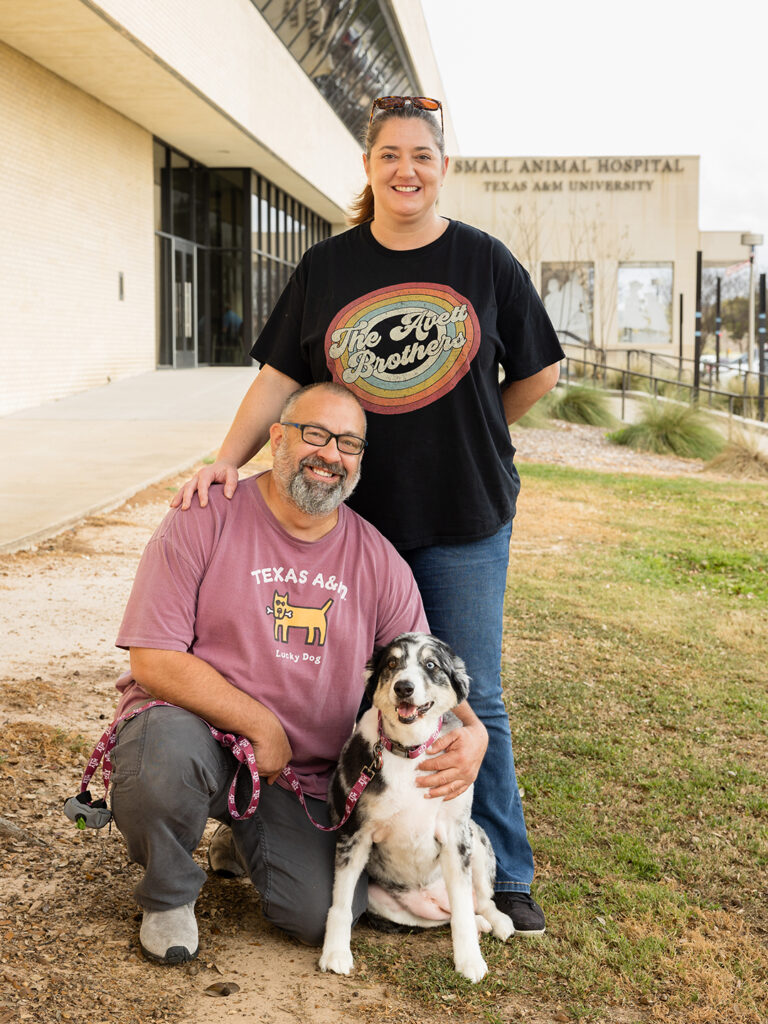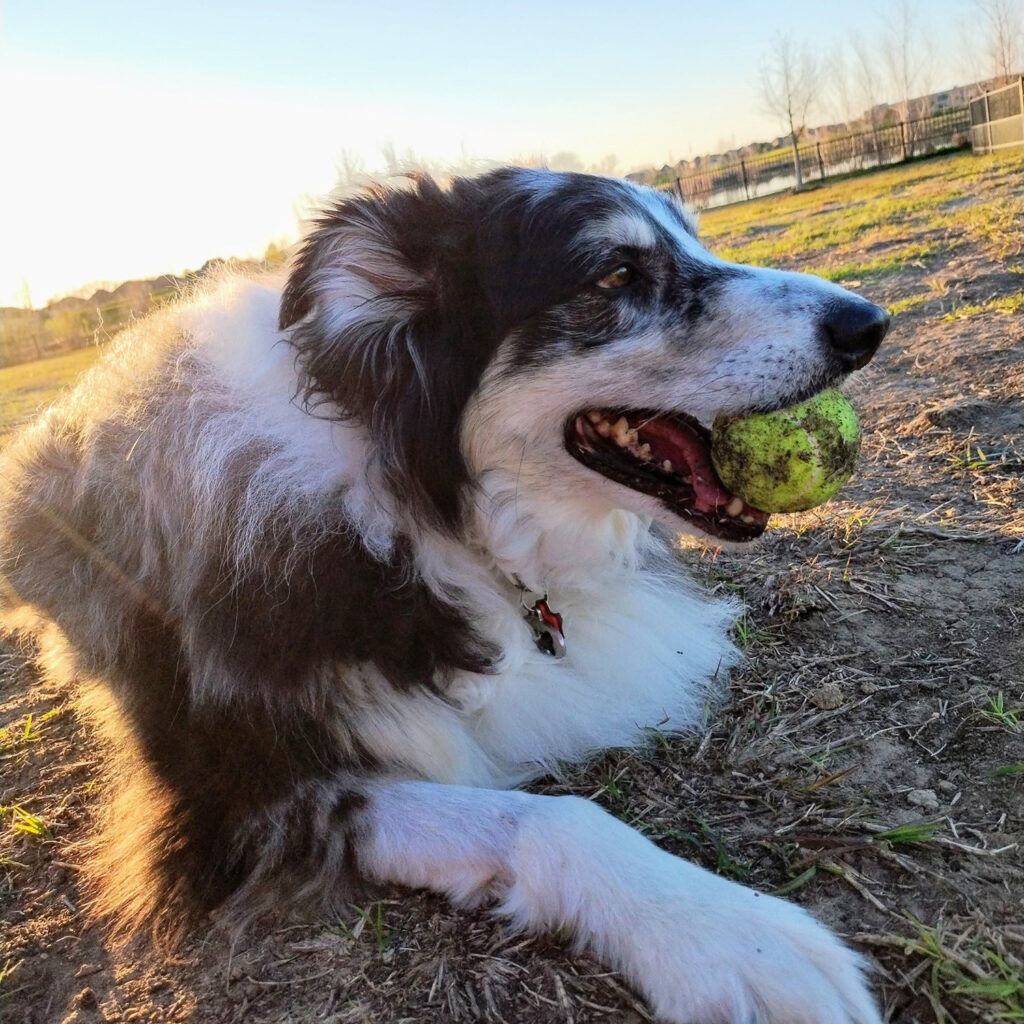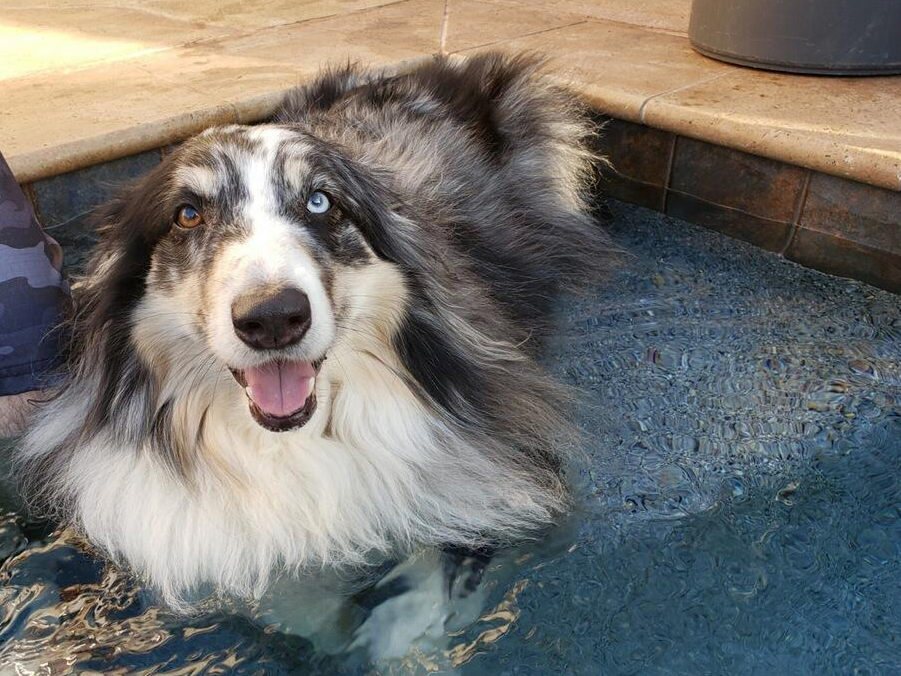Australian Shepherd Receives Three Life-Saving Surgeries At Texas A&M Veterinary Hospital
Story by Megan Bennett, VMBS Communications

Photo by Jason Nitsch ’14, Texas A&M University Division of Marketing and Communications
An 8-year-old Australian Shepherd named Ollie survived a monthlong onslaught of unexpected health emergencies thanks to the veterinarians, staff, and students at the Texas A&M Small Animal Teaching Hospital (SATH).
During her time at the SATH, Ollie received three life-saving surgeries that began with treatment for bladder stone complications but ended with dangerous blood clots.
At many points, Ollie’s condition was grim enough to make her caretakers from several SATH service teams worry about her survival, but they never gave up hope and continued to adapt to the circumstances to do whatever was necessary to save her life and ensure her return home to her family.
Finding The Best Care
When Adam and Kelly Poranski first brought Ollie home as a puppy, they had no idea of the joy she would come to provide for their family.
“She is my wife’s coworker, her best friend, her gal pal,” Adam said. “She’s our little comfort animal.”
“She’s such a loving little girl and always tries to please,” Kelly added. “She’s also such a goofball. She trained us to sing and dance in the kitchen because it makes her happy.”
Last September, the Poranskis noticed that Ollie was urinating more than usual and took her to their local veterinarian.
“We took her in thinking that she had a bladder infection; they gave her some antibiotics, but it still didn’t go away,” Kelly said. “When we brought her back, they did an ultrasound and saw that she had some bladder stones.”
After her veterinarian performed surgery to remove the stones, Ollie seemed to be recovering smoothly until about a week later, when her owners noticed that she was lethargic and not eating well.
Trusting their instincts that something was seriously wrong, the couple decided to bring Ollie to College Station, where she was checked in to the SATH’s Emergency & Critical Care (ECC) Service on Nov. 1.
“They were amazing right from the get-go, when they came out with a gurney and helped get her out of the car,” Adam said. “We took comfort in knowing that we were taking her to a place where she would get the best care possible.”
One Challenge At A Time

Photo by Kelly Poranski
Ollie’s veterinary team, led by ECC resident Dr. Ricardo Martinez, immediately noticed that her abdomen was distended, so they performed a series of ultrasounds — known as an abdominal Focused Assessment with Sonography for Trauma (aFAST) — that revealed an excessive amount of fluid in her abdomen.
After doing some initial diagnostics on the fluid and having knowledge of her recent surgery, they concluded that the fluid was urine and that it was leaking from the incision on the bladder.
“We call this a uroabdomen, which basically means she had urine leaking into her belly around her organs,” said Dr. Vanna Dickerson, an assistant professor in the Soft Tissue Surgery Service. “The bladder is specifically made to hold urine, but it’s very irritating to the other abdominal organs to have urine touching them.”
Dickerson’s team performed surgery to remove the urine and reseal the incision site and then kept Ollie at the SATH for observation. Once again, everything seemed to be going well until Ollie began showing more signs of discomfort about a week later.
After performing another abdominal ultrasound, Ollie’s veterinarians discovered that blood clots had formed in the vessels leading to her spleen, cutting off blood flow to the organ and causing its tissues to stop functioning.
“Certain disease processes, such as an uroabdomen, can cause the body to dysregulate its ability to form and break down clots, and, in Ollie’s case, her body was making clots really easily,” said Dr. Amanda Storer, an ECC resident who worked on Ollie’s case. “We knew her spleen needed to come out because it was no longer viable and likely the reason for her noted discomfort.”
After removing her spleen, Ollie’s veterinarians began closely monitoring her platelet numbers and clotting characteristics in order to watch for future blood clots and get her on anticlotting medication as soon as possible.
“They did a lot of testing to monitor the clotting and get her body to calm down,” Dickerson said. “It can be tricky, though, because it’s a fine balance; you don’t want the patient to make no clots at all and then risk bleeding out.”
Despite their best efforts, Ollie soon developed another clot in her right hind leg, which resulted in two toes losing blood flow and needing to be amputated. Once those toes were removed, however, Ollie began improving and was finally discharged about a month after her arrival.
A Team Effort

Photo by Kelly Poranski
The Poranskis, who had visited Ollie at the SATH at least once a week, were overjoyed when they were finally able to take her home.
“Dr. Storer and two fourth-year students, Madeleine (Swindell) and Ali (Fowler), will hold a special place in my heart forever,” Kelly said. “They were just amazing, calling us anytime there was a little milestone to share the good news. We were so comforted by the fact that we knew she was getting love.”
In the end, dozens of clinicians and staff members from the Soft Tissue Surgery and ECC services were crucial for Ollie’s recovery, including Drs. Shayna Doyle, Marie Min, Cody Riffe, Gabriela Rivas, and Molly Wart.
“It took a whole team and the fact that the owners pushed along and kept going,” Storer said. “If it wasn’t for them agreeing to our recommendations, Ollie probably would not have made it.”
The Poranskis find joy every day watching Ollie run and play again. They are also thankful to have received financial help thanks to the Veterinary Valor Fund, which covered a portion of Ollie’s medical bills because of Adam’s status as a U.S. Navy veteran.
“I’m so glad that we made the decision to bring her to A&M,” Kelly said. “A&M saved her life multiple times, and I truly believe that if she were anywhere else, we wouldn’t have her here with us today.”
###
For more information about the Texas A&M School of Veterinary Medicine & Biomedical Sciences, please visit our website at vetmed.tamu.edu or join us on Facebook, Instagram, and Twitter.
Contact Information: Jennifer Gauntt, Director of VMBS Communications, Texas A&M School of Veterinary Medicine & Biomedical Sciences, jgauntt@cvm.tamu.edu, 979-862-4216


